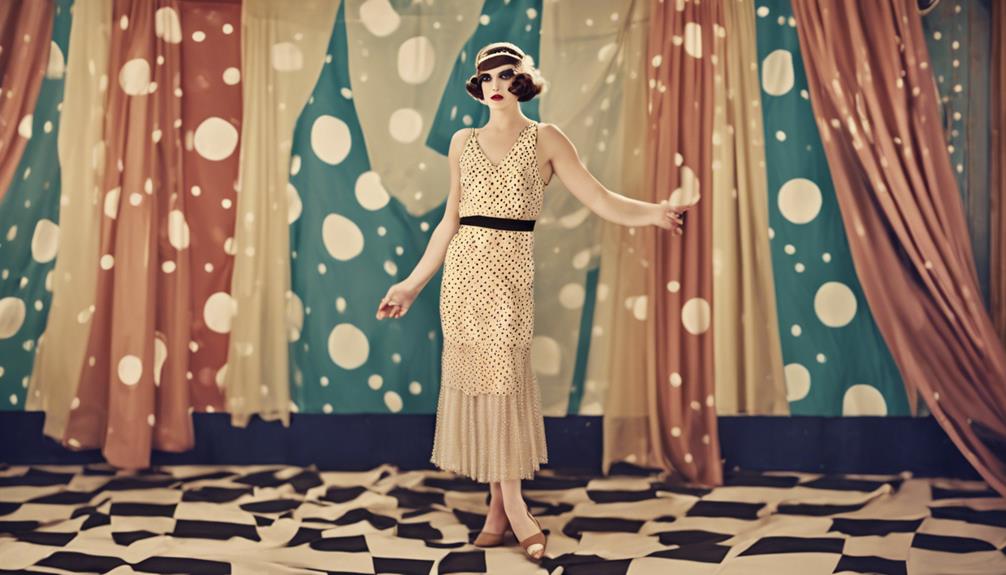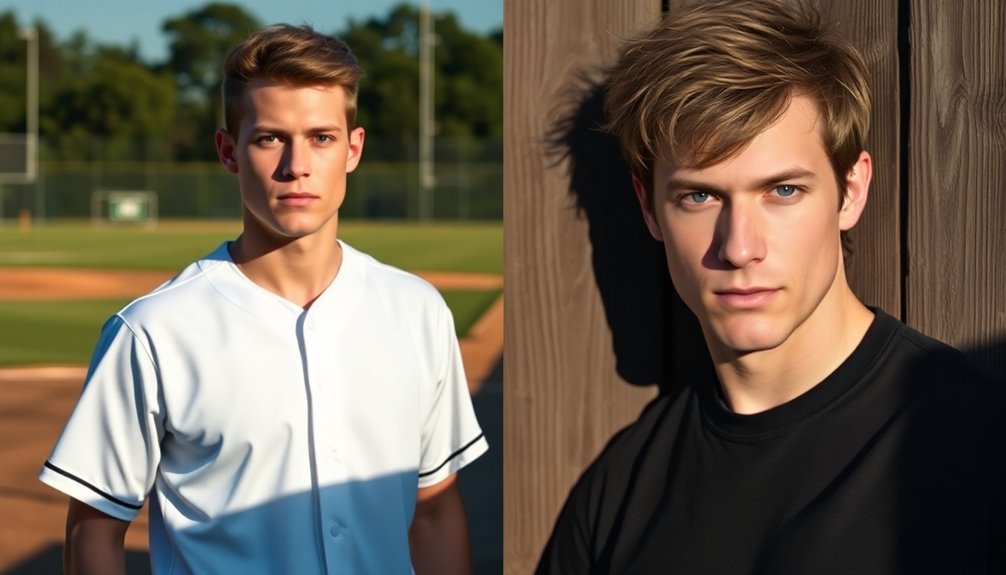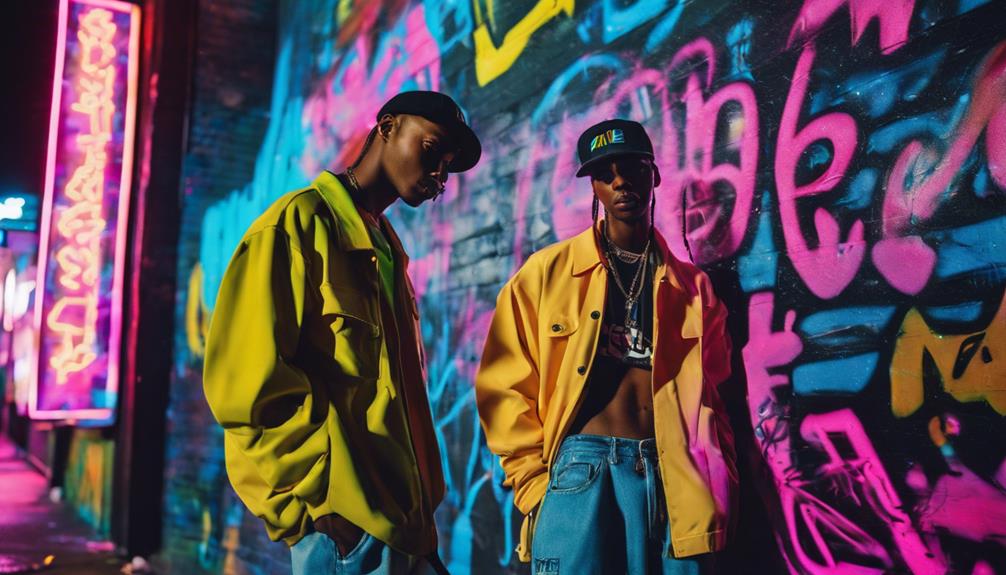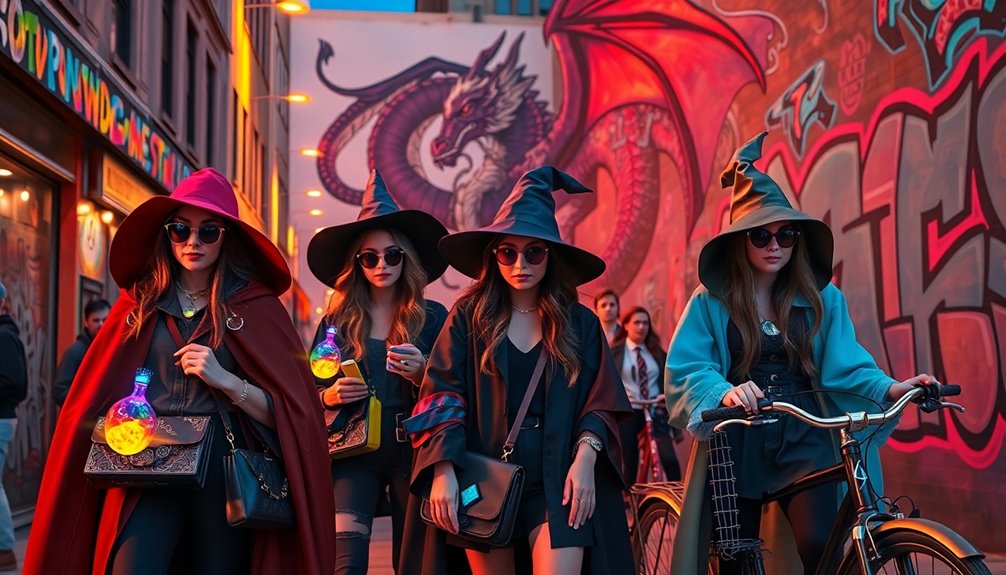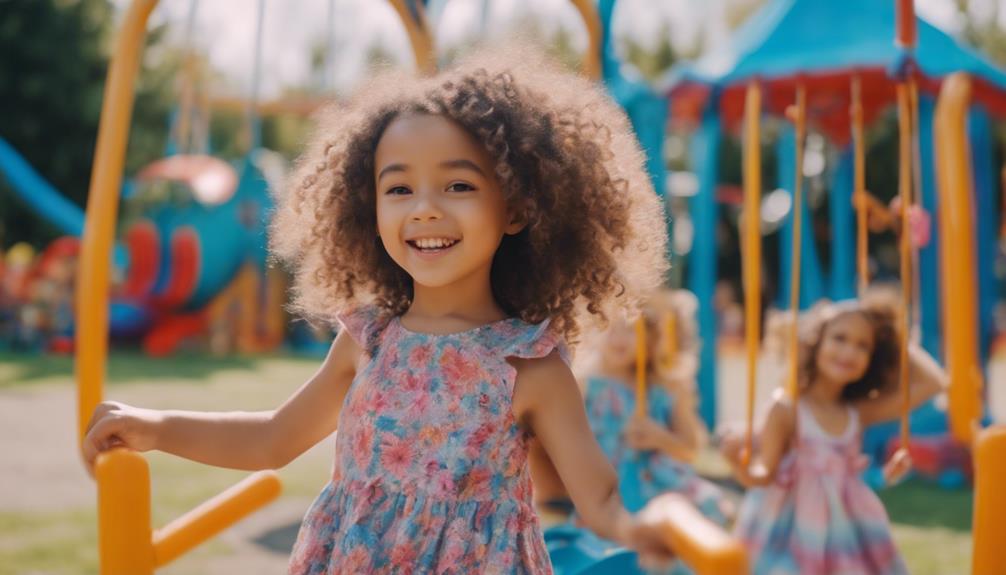The fashion from the 1920s, specifically the flapper style, continues to have a lasting impact and influence today. Iconic elements such as beaded dresses and cloche hats represent freedom and femininity. The 20s also brought about more relaxed silhouettes, allowing for bold self-expression. Modern interpretations combine these vintage styles with a contemporary twist, resulting in unique outfits that are both fashionable and sustainable. By mixing vintage-inspired pieces with modern accessories, you can achieve a look that pays tribute to this vibrant era. Keep exploring to discover more tips on incorporating 20s fashion into your wardrobe.
Key Takeaways
- The 1920s flapper style symbolizes women's liberation with iconic pieces like flapper dresses and cloche hats.
- Fashion in the 1950s celebrated femininity through Christian Dior's New Look, featuring cinched waists and elegant silhouettes.
- Bold prints and vibrant hues emerged in the 1960s and 1970s, reflecting rebellion and creativity in fashion.
- Accessories like pearls and oversized sunglasses were essential for expressing individuality across various decades.
Origin and historical background of the fashion trend/style
When you explore the origins of fashion, you'll see how historical events shape styles over time.
Each era brought forward fashion icons who defined trends, reflecting society's values and attitudes.
Understanding this transformation gives you insight into the unique characteristics of 20's fashion styles.
Fashion's Transformative Journey
Fashion's transformative journey unfolds through each decade, reflecting the cultural and societal shifts that have shaped our understanding of style and identity.
Examining fashion history reveals how trends emerge and evolve, often serving as a mirror to the times. For instance, the flapper dresses of the 1920s symbolized women's liberation, while the 1950s introduced Christian Dior's New Look, celebrating femininity with cinched waists and full skirts. These styles have an enduring appeal, showcasing a timeless style that resonates even today.
As the 1960s rolled in, the Mod Revolution took center stage, with bold patterns and the iconic miniskirt representing youthful rebellion.
Fast forward to the 1980s, where power dressing with sharp shoulder pads reflected women's empowerment in the workplace, ushering in a cultural transformation.
Today, fashion trends continue to evolve, focusing on sustainability and individuality, echoing the cyclical nature of style throughout history.
Your personal fashion choices can be a part of this transformative journey, allowing you to connect with the past while making a statement in the present. Embrace the rich tapestry of fashion history that shapes who you are today.
Fashion Icons of Each Era
Each era boasts its own fashion icons who not only set trends but also reflected the values and attitudes of their time, shaping the landscape of style in profound ways.
In the 1920s, the Flapper style emerged, championed by icons like Coco Chanel and Zelda Fitzgerald. Their short skirts and bobbed hair symbolized a newfound freedom for women, breaking away from traditional norms.
As the 1930s rolled in, Hollywood Glamour took center stage. Stars like Jean Harlow and Greta Garbo showcased elegance with bias-cut dresses and tailored suits, embodying sophistication and luxury.
The 1940s introduced wartime fashion, where Rosie the Riveter emerged as a powerful symbol of female empowerment amidst fabric rationing.
The 1950s brought the New Look, a revolutionary design by Christian Dior that celebrated the hourglass silhouette. Icons like Marilyn Monroe and Grace Kelly popularized this style, emphasizing femininity.
Finally, the Mod Revolution of the 1960s, led by figures like Mary Quant and The Beatles, introduced bold patterns and the iconic miniskirt, capturing the spirit of youthful rebellion and cultural change.
These fashion icons have undeniably left their mark on history.
Key Characteristics
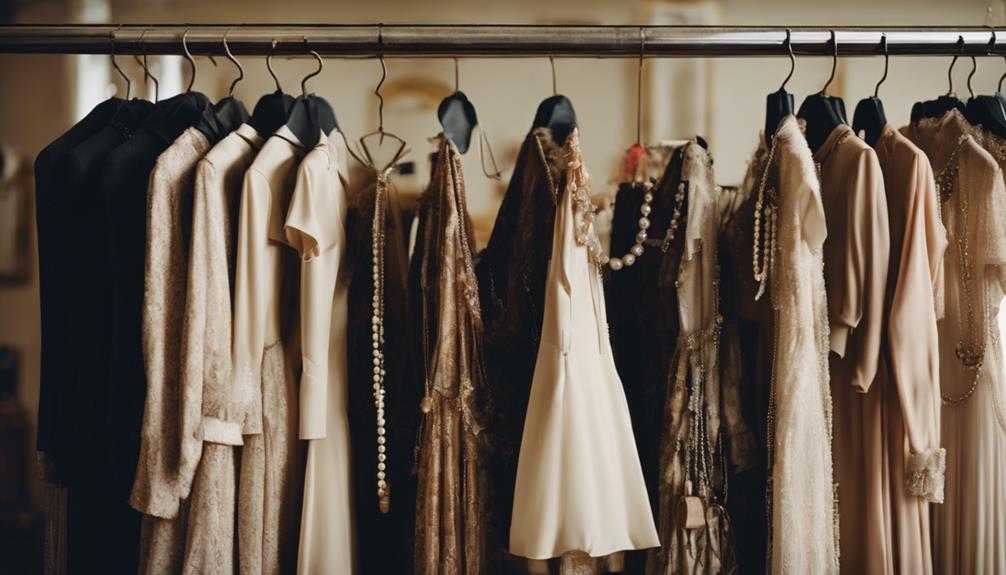
In the 20s, you'll notice distinctive signature silhouettes and patterns that define the era's style.
Bold prints and vibrant hues make a statement, adding energy to every outfit.
Plus, don't forget the signature accessories and footwear that complete your look and showcase your unique flair.
Signature Silhouettes and Patterns
Signature silhouettes and patterns define the essence of each decade, showcasing the evolving trends and cultural shifts that shape personal style.
In the 1950s, you'd find signature silhouettes like the iconic hourglass figure, epitomized by Christian Dior's New Look, which featured cinched waists and full skirts that celebrated femininity.
Moving into the 1960s, bold geometric patterns took center stage with the revolutionary mini skirt, symbolizing youthful rebellion and liberation.
As the 1970s rolled in, flowing silhouettes emerged, embracing bohemian chic with natural fabrics and high-waisted flared trousers, reflecting a laid-back aesthetic.
The 1980s brought a dramatic shift with power dressing, where sharp shoulder pads and structured blazers became essential, representing women's empowerment in the workplace.
Timeless patterns like polka dots and houndstooth have also stood the test of time, often reinterpreted in modern designs while retaining their classic charm.
These signature silhouettes and timeless patterns not only highlight the fashion of their times but also offer you a rich tapestry of styles to draw inspiration from today.
Bold Prints and Vibrant Hues
Bold prints and vibrant hues burst onto the fashion scene in the 1960s and 1970s, reflecting a spirit of rebellion and creativity that continues to influence today's styles. Designers like Mary Quant and Emilio Pucci championed bold patterns, with Pucci's swirling designs capturing the essence of the psychedelic era. The 1960s showcased geometric shapes and bright colors, which became a visual representation of cultural shifts.
As you explore contemporary fashion, you'll notice how these bold prints and vibrant hues remain relevant. The 1970s introduced bohemian chic, with floral motifs and earthy tones worn by icons like Jane Birkin and David Bowie, establishing a laid-back yet artistic aesthetic. Today, fashionistas embrace these influences by incorporating similar patterns and colors into their wardrobes, celebrating the cyclical nature of style.
Electric blues, hot pinks, and sunny yellows, first popularized in the 1980s, also find their way into modern collections, reaffirming the power of color in self-expression. By integrating these elements, you can create outfits that not only honor the past but also make a statement in today's fashion landscape.
Signature Accessories and Footwear
Accessories and footwear play an essential role in defining your style, allowing you to express individuality and complete any outfit with flair.
Consider incorporating signature accessories that reflect your personality. For instance, the elegant pearls and gloves from the 1950s capture classic femininity and sophistication, while the cloche hats and long strands of beads from the 1920s evoke a sense of liberation and modernity.
As you explore timeless styles, don't overlook the bold statement pieces from the 1960s, like oversized sunglasses and statement handbags, which embody the youthful spirit of the Mod Revolution. For a more relaxed vibe, the 1970s bohemian trend offered fringe bags and platform shoes, celebrating free-spirited aesthetics and self-expression.
When it comes to footwear, classic styles remain relevant. The stiletto heel, introduced in the 1950s, and the enduring ballet flat are perfect examples of timeless footwear that can elevate any outfit.
Modern Interpretation
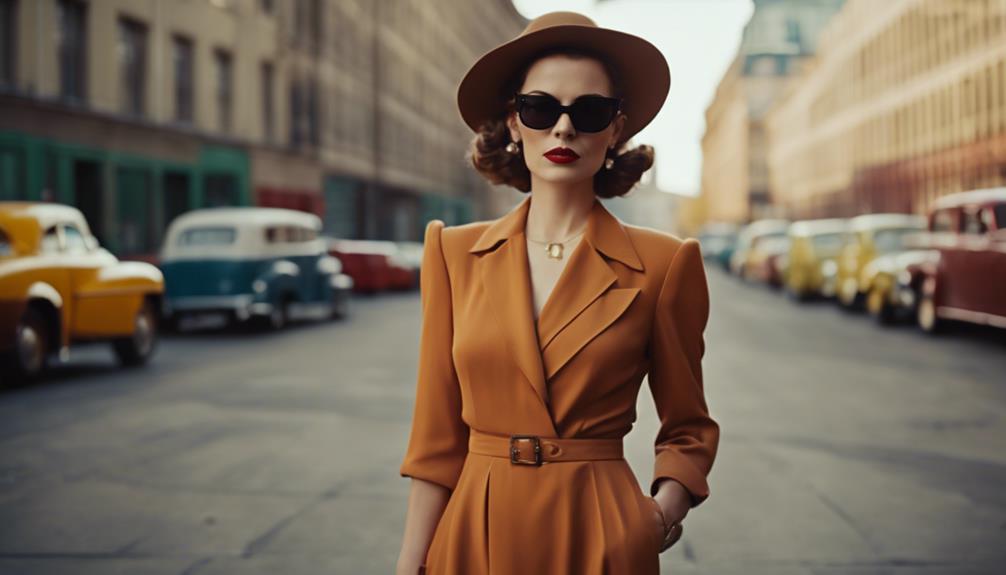
In today's fashion scene, digital innovations are reshaping how you experience and create style.
Emerging sustainable fashion labels aren't just about eco-friendliness; they're redefining what it means to be chic while making a positive impact.
Plus, fashion icons of today are blending vintage inspiration with modern flair, showcasing how past and present can unite in your wardrobe.
Digital Fashion Innovations
Digital fashion innovations are transforming how you experience style, blending virtual clothing with modern technology to create unique and immersive fashion experiences. The rise of augmented reality (AR) allows you to try on digital garments right from your smartphone, enhancing your online shopping journey and cutting down on return rates. Imagine slipping into a stunning virtual outfit before you even hit ‘buy'!
Fashion brands are increasingly collaborating with digital artists and influencers, launching limited-edition virtual collections that merge traditional fashion with cutting-edge technology. This is where non-fungible tokens (NFTs) come into play, revolutionizing the industry by giving you a way to own unique digital fashion pieces, creating exciting new revenue streams for designers.
Additionally, the concept of phygital fashion is gaining momentum. It merges physical and digital experiences, making your shopping experience more immersive and reflective of today's evolving consumer landscape. With digital fashion, you're not just wearing clothes; you're participating in a vibrant, ever-evolving world where style knows no boundaries.
Embrace these innovations and elevate your fashion game in ways you never thought possible!
Emerging Sustainable Fashion Labels
Embracing eco-friendly practices, emerging sustainable fashion labels are redefining modern style with their commitment to using organic materials and reducing waste. These brands prioritize sustainable fashion, focusing on transparency in their supply chains to build consumer trust.
You'll find that many of these labels incorporate vintage and upcycled materials, allowing you to enjoy timeless designs while promoting a more sustainable wardrobe.
As you explore these new collections, you'll notice a significant trend: the fusion of modern aesthetics with classic styles. Collaborations between sustainable brands and established designers create unique pieces that appeal to diverse tastes, making it easy for you to express your individuality.
The rise of slow fashion principles encourages you to invest in high-quality, durable pieces that last, reducing the need for constant replacements.
Fashion Icons of Today
Today's fashion icons effortlessly merge contemporary trends with timeless styles, showcasing their unique interpretations that inspire individuality and self-expression. Figures like Rihanna and Zendaya are redefining the landscape, seamlessly blending vintage aesthetics with modern sensibilities. They draw from the past, creating looks that resonate with both nostalgia and innovation, appealing to the modern woman who values authenticity in her wardrobe.
Social media influencers play a significant role in this evolution, promoting body positivity and diversity much like the style revolutions of the 1960s and 1970s. You'll notice that fashion campaigns today often feature classic silhouettes enhanced by bold patterns and textures, highlighting the cyclical nature of style.
Designers like Alessandro Michele at Gucci and Demna Gvasalia at Balenciaga are at the forefront of this movement, reinterpreting vintage aesthetics to cater to today's fashion enthusiasts. Additionally, the rise of sustainable fashion has seen these icons advocate for eco-friendly practices, reflecting a commitment to ethical consumption.
As you explore their styles, remember that today's fashion icons not only celebrate timeless styles but also pave the way for future trends, encouraging you to embrace your unique fashion journey.
Styling Tips
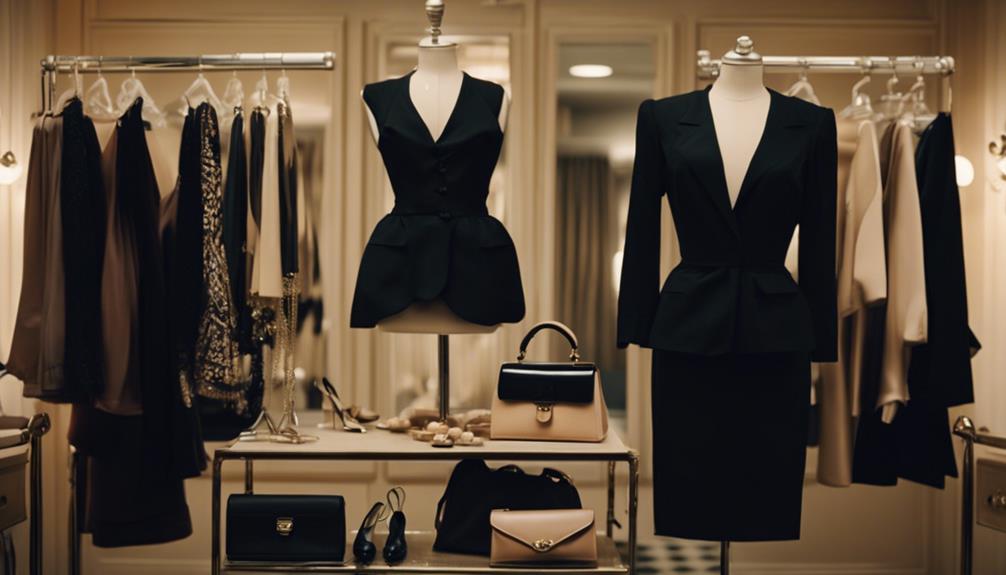
When it comes to styling, you can't go wrong with a timeless little black dress; it's a versatile staple that works for any occasion.
Try mixing vintage-inspired pieces with modern items to create a unique look that stands out.
Layering is key, so don't hesitate to play with different textures and silhouettes for a fresh twist on classic outfits.
Timeless Little Black Dress
The Little Black Dress (LBD) is a versatile essential that effortlessly adapts to any occasion with the right styling choices. This timeless piece, popularized by Coco Chanel in the 1920s, remains a staple in every wardrobe.
When selecting your LBD, focus on the silhouette that best enhances your personal style. Whether you prefer a sheath, A-line, or fit-and-flare, each option flatters various body types and makes a striking statement.
To achieve iconic looks, consider your accessories. For formal events, elevate your LBD with statement jewelry, like bold earrings or a chic clutch. When dressing down, throw on a denim jacket and some ankle boots for an effortlessly cool vibe.
The beauty of the little black dress lies in its adaptability; layer it with a turtleneck for chillier days or keep it simple for a summer outing.
Vintage-Inspired Ensemble Combinations
Building on the versatility of the little black dress, vintage-inspired ensembles offer a unique way to express personal style while drawing inspiration from fashion's rich history.
One classic and timeless combination is pairing a vintage-inspired A-line skirt with a tucked-in button-down shirt. This look embodies the 1950s elegance that defined an era of grace and femininity. For a more playful vibe, mix patterned vintage blouses with solid-color midi skirts, capturing the bold spirit of Mod fashion from the 1960s.
Don't forget to accessorize! Adding bold statement jewelry to your little black dress pays homage to Audrey Hepburn's iconic style, allowing you to showcase your personality. Additionally, consider a fitted blazer paired with high-waisted wide-legged trousers for a nod to 1970s bohemian chic while maintaining a modern silhouette.
These combinations not only celebrate fashion's past but also enable you to create unique outfits that reflect your individuality. Embrace these vintage-inspired looks, and let your wardrobe tell a story that bridges the classic with the contemporary.
Layering Vintage With Modern Pieces
Layering vintage pieces with modern items can create a stylish and unique outfit that showcases your personal flair. Start with a classic foundation, like a tailored blazer or a vintage dress, to set the tone for your ensemble. For a fresh twist, pair vintage high-waisted trousers with a contemporary cropped top; this balances the silhouette beautifully.
To modernize the look without overshadowing the vintage elements, incorporate modern accessories such as minimalist jewelry or sleek footwear. Mixing vintage patterns, like florals or paisleys, with solid modern pieces adds a dynamic contrast, allowing each style to stand out while complementing one another.
Don't shy away from layering textures, either. A vintage knit sweater combined with a modern leather jacket can create an eye-catching and stylish ensemble that highlights both eras.
Shopping Guide
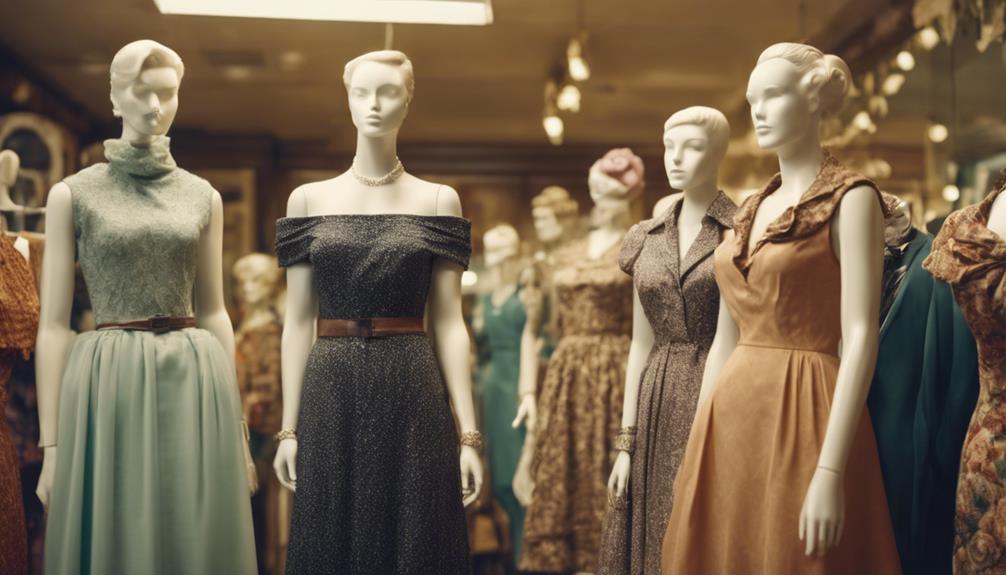
Finding the right pieces for your wardrobe can transform your style and elevate your confidence. When shopping for timeless styles, focus on classic pieces like trench coats, tailored blazers, and the iconic little black dress. These garments have proven their versatility, seamlessly adapting through seasons and occasions.
Explore vintage shops and thrift stores for unique finds that embody the charm of past decades. You'll often discover stylish items at more affordable prices compared to fast fashion alternatives. While browsing, pay attention to the fabric and craftsmanship; well-made garments from sustainable brands tend to use natural materials like cotton, wool, and silk, enhancing their durability and timeless appeal.
Prioritize quality over quantity by investing in items that stand the test of time. Consider the versatility of each piece you choose; select items that can be styled in multiple ways, allowing for effortless shifts from casual outings to formal events.
With a keen eye for timeless styles and classic pieces, you'll build a wardrobe that not only looks great but also reflects your commitment to sustainability and individuality. Happy shopping!
Upcycling Vintage Clothing Ideas
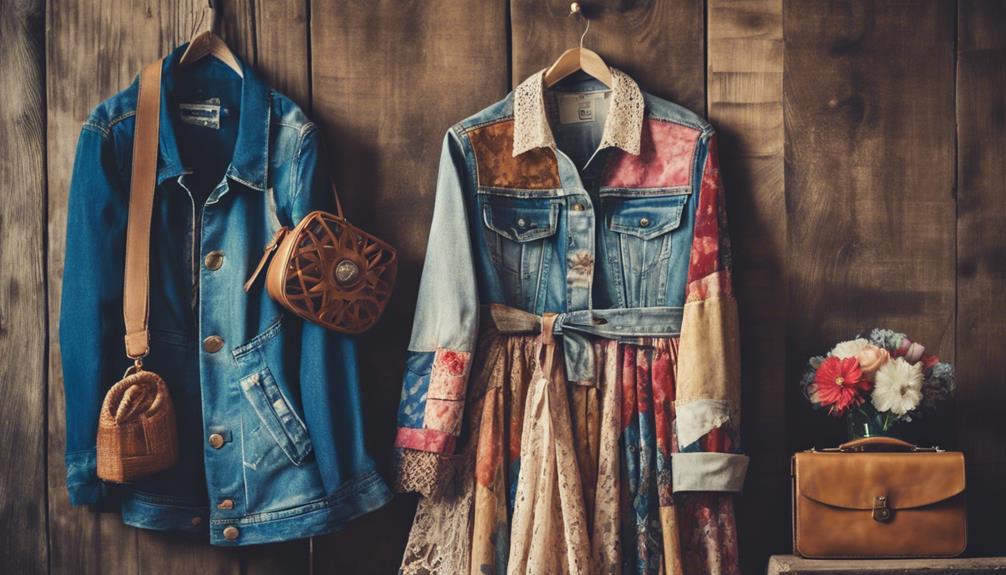
Upcycling vintage clothing isn't just about transforming old garments; it's also a chance to get creative with accessories.
You can easily repurpose vintage pieces and add personalized embellishments to your wardrobe.
Let's explore how you can turn forgotten finds into unique fashion statements!
Repurposing Vintage Accessories
Repurposing vintage accessories can effortlessly elevate your outfits, adding a unique touch while celebrating the charm of the past.
By embracing upcycling, you can breathe new life into vintage clothing, transforming old pieces into something fresh and stylish. Think about how you can use vintage accessories like brooches, scarves, or belts to modernize your look.
For instance, a vintage scarf can be tied around your handbag for a pop of color, or a brooch can be pinned on a simple jacket, turning it into a statement piece. These small changes not only highlight your personal style but also showcase the beauty of unique garments from another era.
Thrifting for vintage accessories encourages resourcefulness and eco-friendly practices, allowing you to find truly one-of-a-kind items that resonate with your fashion sense.
You'll be surprised at how combining these elements can create a fresh outfit that feels both contemporary and timeless. So, don't shy away from experimenting with vintage accessories; they're the perfect way to express your individuality while making sustainable choices in fashion.
Personalized Embellishments for Vintage Wear
Adding personalized embellishments to vintage wear not only enhances its uniqueness but also lets you showcase your creativity and style.
Upcycling vintage clothing is a fantastic way to breathe new life into old pieces while embracing sustainable fashion practices. You can add lace, beads, or embroidery to enhance the garment's charm and individuality. Techniques like fabric painting or patchwork can revitalize these items, allowing for creative expression while honoring their history.
Consider replacing basic buttons with vintage or decorative options; this simple change can instantly transform an ordinary piece into something eye-catching and customized.
Adding appliqués or trims not only refreshes your vintage wear but also allows you to incorporate current trends into classic designs, merging the old with the new.
Cultural Impact
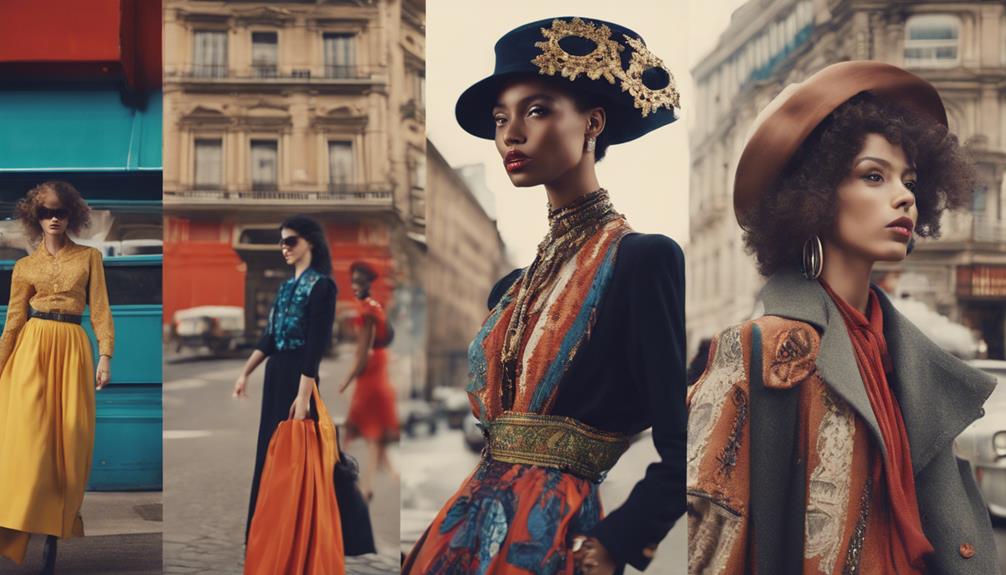
Fashion in film and music has always shaped cultural narratives, influencing how you perceive style and identity.
Think about how iconic movies and music artists set trends that resonate with social movements and civil rights.
As you explore these connections, you'll see how fashion becomes a powerful tool for expression and change.
Fashion in Film and Music
Film and music have long shaped public perceptions of style, with iconic looks from the silver screen and stage inspiring generations to express their individuality.
Think about Audrey Hepburn's little black dress in 'Breakfast at Tiffany's'—it's a timeless style that still resonates today. Music icons like David Bowie and Madonna revolutionized fashion trends with their bold, eclectic styles, encouraging you to embrace your unique identity.
The rise of music videos in the 1980s and 1990s, particularly on MTV, transformed fashion marketing, making artists' looks a central focus and influencing consumer trends worldwide. These visuals created a platform where fashion in film and music intertwined, shaping what's popular and desirable.
Events like the Met Gala exemplify this cultural significance, often celebrating the intersection of these two art forms and showcasing how cinematic and musical styles impact contemporary fashion.
Additionally, fashion designers frequently collaborate with filmmakers and musicians to craft unique, trend-setting looks. Partnerships like those between Gucci and various artists highlight the ongoing dialogue between fashion and popular culture, proving that this connection is as influential now as it's ever been.
Fashion and Civil Rights
Clothing has often served as a powerful tool for expressing resistance and unity within the civil rights movement, with individuals using their attire to convey messages of dignity and cultural pride. Fashion choices made by iconic figures like Rosa Parks and Martin Luther King Jr. highlighted the importance of representation and self-expression during this pivotal time.
In the 1960s, the Black Power movement ushered in styles like afros and dashikis, symbolizing a proud rejection of Eurocentric beauty standards. These choices became acts of activism, showcasing cultural pride and unity. You might notice how coordinated attire during protests, like the color black in Black Lives Matter events, denotes solidarity and mourning, further emphasizing how fashion can communicate powerful messages.
Moreover, the civil rights movement opened doors for African American designers and models, greatly impacting representation in the fashion industry. Today, the evolution of streetwear continues this legacy, as marginalized communities embrace fashion as a means of self-expression and resistance against oppression, influencing global trends.
Frequently Asked Questions
What Fashion Style Is Timeless?
Timeless fashion styles include the little black dress, tailored suits, and classic trench coats. They're versatile, elegant, and never go out of style. You'll always look chic when you wear these enduring pieces.
What Were 4 Fashion Styles of the 1970s?
In the 1970s, you'd encounter Bohemian Chic, Disco fashion, Punk style, and bell-bottomed trousers. Each represented unique cultural movements, showcasing flowing fabrics, vibrant colors, and rebellious attitudes that defined an iconic decade in fashion.
What Are the Fashion Eras in Order?
To understand fashion eras in order, start with the 1900s' S-silhouette, then the 1920s' Flappers, followed by the glamorous 1930s, the practical 1940s, the curvy 1950s, and finally, the youthful 1960s' Mod Revolution.
What Is the History of Classic Fashion Style?
Classic fashion style evolved through significant historical moments, reflecting social changes. You'll notice how each era introduced unique silhouettes and materials, emphasizing timeless pieces like the little black dress that continue to influence today's trends.
Conclusion
Incorporating timeless styles from the past into your wardrobe can breathe new life into your fashion game.
By understanding the origins and characteristics of these trends, you can create modern interpretations that reflect your unique style.
Use the styling tips and shopping guide to find pieces that resonate with you, and don't forget to upcycle vintage clothing for a sustainable twist.
Embrace these classic looks, and let your fashion choices celebrate the rich cultural impact of the past!
